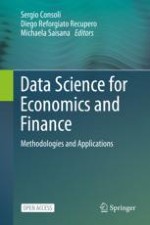1 Introduction
2 Methodology to Create Text-Based Indicators
2.1 From Text to Numerical Data
2.1.1 Keywords Generation
2.1.2 Database Querying
2.1.3 News Filtering
-
Removal of texts that have no connection with the topic to study, for example, articles dealing with sports or lifestyle.
-
Removal of articles that are too long (e.g., lengthy interviews) or too short (being more prone to a biased measurement of relevance and sentiment). Instead of removing the longer-than-usual articles, one could proceed with the leading paragraph(s) or a summary.
-
Removal of exact duplicated entries or highly related (near-duplicated) entries.
-
Removal of texts that are subject to database-specific issues, such as articles with a wrong language tag.
2.1.4 Indicators Construction
2.2 Validation and Decision Making
3 Monitoring the News About Company ESG Performance
3.1 Motivation and Applications
3.1.1 Text-Based ESG Scoring as a Risk Management Tool
3.1.2 Text-Based ESG Scoring as an Investment Tool
3.2 Pipeline Tailored to the Creation of News-Based ESG Indices
3.2.1 Word Embeddings and Keywords Definition
E | S | G | Sentimenta
|
|---|---|---|---|
milieu (environment), energie (energy), mobiliteit (mobility), nucleair (nuclear), klimaat (climate), biodiversiteit (biodiversity), koolstof (carbon), vervuiling (pollution), water, verspilling (waste), ecologie (ecology), duurzaamheid (sustainability), uitstoot (emissions), hernieuwbaar (renewable), olie (oil), olielek (oil leak) | samenleving (society), gezondheid (health), mensenrechten (human rights), sociaal (social), discriminatie (discrimination), inclusie (inclusion), donatie (donation), staking (strike), slavernij (slavery), stakeholder, werknemer (employee), werkgever (employer), massaontslag (mass fire), arbeid (labor), community, vakbond (trade union), depressie (depression), diversiteit (diversity) | gerecht (court), budget, justitie (justice), bestuur (governance), directie (management), omkoping (bribery), corruptie (corruption), ethiek (ethics), audit, patentbreuk (patent infringement), genderneutraal (gender neutral), witwaspraktijken (money laundering), dierproeven (animal testing), lobbyen (lobbyism), toploon (top wage) | vervuiling, verspilling, olielek, discriminatie, staking, slavernij, massaontslag, depressie, omkoping, corruptie, patentbreuk, witwaspraktijken |
3.2.2 Company Selection and Corpus Creation
3.2.3 Aggregation into Indices
3.2.4 Validation
Detected | Time gain (days) | |||||
|---|---|---|---|---|---|---|
Events |
f
|
s
|
f
|
s
| ||
E | 53% | 19% | 11% | 48 | 48 | |
S | 53% | 34% | 24% | 52 | 52 | |
G | 63% | 25% | 19% | 51 | 46 | |
ESG | 24% | 28% | 18% | 52 | 47 | |
3.3 Stock and Sector Screening
-
Invest in the 100 top-performing companies. [S1]
-
Invest in the companies excluding the 100 worst-performing ones. [S2]
-
Invest in the companies in the 10 top-performing sectors. [S3]
3.3.1 Aggregate Portfolio Performance Analysis

3.3.2 Additional Analysis
s1
|
s2
|
s3
|
s4
|
s5
|
s6
|
s7
|
s8
| |
|---|---|---|---|---|---|---|---|---|
E | 1.01 | 1.04 | 0.99 | 0.99 | 1.04 | 1.02 | 1.04 | 1.02 |
S | 0.98 | 0.99 | 0.98 | 1.00 | 0.98 | 0.95 | 0.95 | 1.01 |
G | 1.14 | 1.17 | 1.20 | 1.20 | 1.16 | 1.19 | 1.09 | 1.17 |
ESG | 1.06 | 1.09 | 1.08 | 1.08 | 1.08 | 1.08 | 1.05 | 1.08 |
